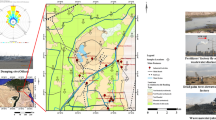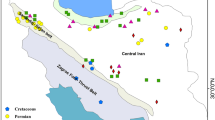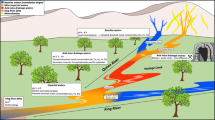Abstract
Changes in the principal sources of Pb in overbank sediment profiles have been documented for two Spanish areas by using Pb isotopes and Pb concentrations. These locations (Madrid and Tinto–Odiel basin) represent two of the most contaminated regions in Spain. The Community of Madrid is characterized by heavy industrial and urban activity, focused mainly in Madrid City. The Tinto–Odiel basin drains the Iberian Pyrite Belt, which hosts many polymetallic massive sulphides and is heavily affected by mining activities in their headwaters. It has been proven that the influence of anthropogenic activity is reflected in these overbank deposits by variations in Pb concentrations that, in general, correlate with shifts in the 206Pb/207Pb ratio. Rivas profile (downstream of Madrid) was found to be the most anthropogenically influenced site. The sediments within this profile which were recently deposited (170 ± 40 years BP) have the least radiogenic signatures. 206Pb/207Pb ratios ranged between 1.1763 and 1.1876 indicating significant contributions of anthropogenic Pb. In contrast, profiles upstream of Madrid possess an average 206Pb/207Pb ratio of 1.2272. It is difficult to clearly identify the most prominent source as the sediments appear to be characterized by an input from several sources. The floodplain profiles in the Tinto–Odiel basin exhibit uniform 206Pb/207Pb ratios ranging from 1.1627 (Odiel river) to 1.1665 (Tinto river). These ratios are similar to the ones possessed by sulphide ores in the area and differ from the ratios of other nonmineralized formations in the basin, indicating that mining activities are the primary, if not sole, source of Pb to the sediments.









Similar content being viewed by others
References
Adánez, P. (2012). La geoquímica de los sedimentos de llanuras de inundación como guía para la valoración ambiental en España. Ph.D Thesis. Universidad Politécnica de Madrid, pp. 504.
Adánez, P., García Cortés, A., & Locutura, J. (2009). La geoquímica en los sedimentos de la llanura de inundación del Manzanares como medio para evaluar el impacto ambiental. Boletín Geológico y Minero, 120(1), 69–80.
Adánez Sanjuán, P., Llamas Borrajo, J., Locutura Rupérez, J., & García Cortés, A. (2014a). A geochemical study of overbank sediments in an urban area (Madrid, Spain). Environmental Geochemistry and Health, 36(6), 1129–1150.
Adánez Sanjuán, P., Llamas Borrajo, J., Locutura Rupérez, J., & García Cortés, A. (2014b). Estudio geoquímico de los sedimentos de llanura de inundación en la cuenca de los ríos Tinto y Odiel (Huelva). Boletín Geológico y Minero, 125(4), 585–599.
Álvarez-Valero, A. M., Sáez, R., Pérez- López, R., Delgado, J., & Nieto, J. M. (2009). Evaluation of heavy metal bio-availability from Almagrera pyrite-rich tailings dam (Iberian pyrite belt, SW Spain) based on sequential extraction procedure. Journal of Geochemical Exploration, 102, 87–94.
Aung, N. N., Uryu, T., & Yoshinaga, J. (2004). Lead isotopic composition of environmental certified reference materials for an inter-laboratory comparison of lead isotope analysis. Analytical Sciences, 20, 195–198.
Ayrault, S., Roy-Barman, M., Le Cloare, M. F., Priadi, C. R., Bonté, P., & Göpel, C. (2012). Lead contamination of the Seine river, France: Geochemical implications of a historical perspective. Chemosphere, 87, 902–910.
Bird, G. (2011). Provenancing anthropogenic Pb within the fluvial environment: Developments and challenges in the use of Pb isotopes. Environment International, 37, 802–819.
Bollhöfer, A., & Rosman, K. J. R. (2001). Isotopic source signatures for atmospheric lead: The Northern Hemisphere. Geochimica et Cosmochimica Acta, 11, 1727–1740.
Bölviken, B., Bogen, J., Demetriades, A., De Vos, W., Ebbing, J., Hindel, R., et al. (1996). Regional geochemical mapping of Western Europe towards the year 2000. Journal of Geochemical Exploration, 56, 141–166.
Cánovas, C. R., Hubbard, C. G., Olías, M., Nieto, J. M., Black, S., & Coleman, M. L. (2008). Hydrochemical variations and contaminant load in the Río Tinto (Spain) during flood events. Journal of Hydrology, 350, 25–40.
Carrasco Martiañez, I. (2000). Historia de la Faja Pirítica Ibérica. Bocamina, 5, 8–49.
Cheng, H., & Hu, Y. (2010). Lead (Pb) isotopic fingerprinting and its applications in lead pollution studies in China: A review. Environmental Pollution, 158, 1134–1146.
Chow, T. J., Snyder, C. B., & Earl, J. L. (1975). Isotope ratios of lead as pollutants source indicators. In: Symposium on isotope ratios as pollutant source and behaviour indicators. Vienna, Austria. Nov 18–22, (1974). International Atomic Energy Agency, Report: STI/PUB/382, 95-108.
De la Cruz, M. T., Laborda, F., Callén, M. S., López, J. M., & Mastral, A. M. (2009). Study of Pb sources by Pb isotope ratios in the airborne PM10 of Zaragoza, Spain. Journal of Environmental Monitoring, 11, 2052–2057.
De Miguel, E., Callaba, A., Arranz, J. C., Cala, V., Chacón, E., Gallego, E., Alberruche, E., Alonso, C., Fdez-Canteli, P., Iribarren, I., & Palacios, H. (2002). Determinación de niveles de fondo y niveles de referencia de metales pesados y otros elementos traza en suelos de la Comunidad de Madrid. Publicaciones de Instituto Geológico y Minero de España. Serie: Medio Ambiente. Terrenos Contaminados. N°2. Madrid. Instituto Geológico y Minero de España, pp. 167.
De Miguel, E., Llamas, J. F., Chacón, E., Berg, T., Larssen, S., Royset, O., & Vadset, M. (1997). Origin and patterns of distribution of trace elements in street dust: unleaded petrol and urban lead. Atmospheric Environment, 31(17), 2733–2740.
Díaz de Neira, J. A., Cabra, P., Hernaiz, P. P., & López Olmedio, F. (2000). Mapa geológico a escala 1:50.000 de la Hoja 534 (Colmenar Viejo). Instituto Geológico y Minero de España, pp. 129.
Doe, B. R. (1970). Lead isotopes (p. 137). Berlin: Springer.
Doe, B. R., & Delevaux, M. H. (1972). Source of lead in Southeast Missouri Galena Ores. Economic Geology, 67, 409–425.
Farmer, J. G., Eades, L. J., Graham, M. C., & Bacon, J. R. (2000). The changing nature of the Pb-206/Pb-207 isotopic ratio of lead in rainwater, atmospheric particulates, pine needles and leaded petrol in Scotland, 1982–1998. Journal of Environmental Monitoring, 2(1), 49–57.
Faure, G. (1977). Principles of isotope geology (p. 464). New York: Wiley.
Garzón, G., & Alonso, A. (1996). El río Guadarrama, morfología y sedimentación actual en un cauce arenoso tipo braided. Cuadernos de Geología Ibérica, 21, 369–393.
Garzón, G., & Alonso, A. (2002). Comparison of the flood response of a braided and a meandering river, conditioned by anthropogenic and climatic changes. In I. P. Martini, V. R. Baker, & G. Garzon (Eds.), Flood and megaflood processes and deposits: Recent and ancient examples (pp. 233–249). Oxford, UK: Blackwell.
Gulson, B. L. (1984). Uranium-lead and lead-lead investigations of minerals from the Broken Hill lodes and mine sequence rocks. Economic Geology, 79, 476–490.
Gulson, B. L. (1985). Shale-hosted lead-zinc deposits in northern Australia: Lead isotope variations. Economic Geology, 80, 2001–2012.
Hansmann, W., & Köppel, V. (2000). Lead-isotopes as tracers of pollutants in soils. Chemical Geology, 171, 123–144.
Holtzman, R. B. (1970). Isotopic Composition as a natural tracer of lead in the environment. Environmental Science and Technology, 4, 314–317.
Hudson-Edwards, K. A., Schell, C., & Macklin, M. G. (1999). Mineralogy and geochemistry of alluvium contaminated by metal mining in the Rio Tinto area, southwest Spain. Applied Geochemistry, 14, 1015–1030.
IGME. (2007). UTPIA UtilizaÇao do Pb como Indicador de vulnerabilidade Ambiental na Faixa Piritosa Ibérica. Fundo Europeu de Desenvolvimento Regional. Iniciativa Comunitaria Interreg. Portugal-Espanha. CooperaÇao TransfronteriÇa. Interreg IIA.
Komárek, M., Ettler, V., Chrastný, V., & Mihaljevic, M. (2008). Lead isotopes in environmental sciences: A review. Environment International, 34, 562–577.
Langedal, M. (1996). Fluvial dispersion of particle-bound heavy metals: An evaluation of overbank sediments as sampling medium for regional geochemical mapping and environmental studies. Ph.D. Thesis, Norges Teknisk- Naturvitenskapelige Univ. Trondheim, pp. 123.
Leistel, J. M., Marcoux, E., Thiéblemont, D., Quesada, C., Sánchez, A., Almodóvar, G. R., et al. (1998). The volcanic-hosted massive sulphide deposits of the Iberian pyrite belt. Review and preface to the Thematic Issue. Mineralium Deposita, 33, 2–30.
Locutura, J., & Bel-Lan, A. (2011). Systematic urban geochemistry of Madrid, Spain, based on soils and dust. In C. C. Jonson, A. Demetriades, J. Locutura, & R. T. Ottesen (Eds.), Mapping the chemical environment of urban areas (pp. 307–347). Chichester: Wiley.
Locutura, J., Bel-Lan, A., García Cortés, A., & Martínez, S. (2012). Atlas geoquímico de España. Instituto Geológico y Minero de España, pp. 592.
Macklin, M. G. (1996). Fluxes and storage of sediment associated heavy metals in floodplain systems: Assessment and river basin management issues at a time of rapid environmental change. In M. G. Anderson, D. E. Walling, & P. D. Bates (Eds.), Floodplain processes (pp. 441–460). Chichester, UK: Wiley.
Marcoux, E. (1998). Lead isotope systematics of the giant massive sulphide deposits in the Iberian pyrite belt. Mineralium Deposita, 33, 45–58.
Miller, J. R. (2013). Forensic assessment of metal contaminated rivers in the 21st century using geochemical and isotopic tracers. Minerals, 3, 192–246.
Monna, F., Hamer, K., Lévêque, J., & Sauer, M. (2000). Pb isotopes as a reliable marker of early mining and smelting in the Northern Harz province (Lower Saxony, Germany). Journal of Geochemical Exploration, 68, 201–210.
Monna, F., Lancelot, J., Corudace, I. W., Cundy, A. B., & Lewis, J. T. (1997). Pb isotopic composition of airborne particulate material from France and Southern United Kingdom: Implications for Pb pollution sources in urban areas. Environmental Science and Technology, 31, 2277–2286.
Moody, J. A., Pizzuto, J. E., & Meade, R. H. (1999). Ontogeny of a flood plain. Geological Society of America Bulletin, 111, 291–303.
Novák, M., Emmanuel, S., Vile, M. A., Erel, Y., Véron, A., Paces, T., et al. (2003). Origin of lead in eight Central European peat bogs determined from isotope ratios, strengths, and operation times of regional pollution sources. Environmental Science and Technology, 37–3, 437–445.
Nriagu, J. O. (1990). The rise and fall of leaded gasoline. The Science of the Total Environment, 92, 13–28.
Olías, M., Cánovas, C. R., Nieto, J. M., & Sarmiento, A. M. (2006). Evaluation of the dissolved contaminant load transported by the Tinto and Odiel rivers (South West Spain). Applied Geochemistry, 21, 1733–1749.
Orejana, D., Villaseca, C., Pérez-Soba, C., López-García, J. A., & Billström, K. (2009). The Variscan gabbros from the Spanish Central System: A case for crustal recycling in the sub-continental lithospheric mantle. Lithos, 110, 262–276.
Ottesen, R. T., Bogen, J., Bolviken, B., & Volden, T. (1989). Overbank sediment: A representative sample medium for regional geochemical mapping. Journal of Geochemical Exploration, 32, 257–277.
Pastor, F., Leyva, F., Martínez, C., Granados, L. F., Fernández Luanco, M. C., & Alfonso, S. A. (1976). Mapa geológico a escala 1:50.000 de la hoja 1000 (Moguer). Instituto Geológico y Minero de España, pp. 32.
Pomiès, C., Cocherie, A., Guerrot, C., Marcoux, E., & Lancelot, J. (1998). Assessment of the precision and accuracy of lead-isotope ratios measured by TIMS for geochemical applications: example of massive sulphide deposits (Río Tinto, Spain). Chemical Geology, 144, 137–149.
Reimann, C., Englmaier, P., Flem, B., Gough, L., Lamothe, P., Nordgulen, O., & Smith, D. (2009). Geochemical gradients in soil O-horizon simples from southern Norway: Natural or anthropogenic? Applied Geochemistry, 26, 1623–1631.
Reimann, C., Flem, B., Arnoldussen, A., Englmaier, P., Finne, T. E., Koller, F., & Nordgulen, O. (2008). The biosphere: A homogeniser of Pb-isotope signals. Applied Geochemistry, 23, 705–722.
Reimann, C., Smith, D. B., Woodruff, L. G., & Flem, B. (2011). Variations in Pb and Pb-isotope ratios in soils collected along an east-west transect across the United States. Applied Geochemistry, 26, 1623–1631.
Rodríguez, L. R., Hernaiz, P. P., López, F., Cabra, P., Solé, J., Escuder, J., Valverde, P., & Gálvez, C. (2005). Mapa geológico a escala 1:50.000 de la Hoja 459 (Tamajón). Instituto Geológico y Minero de España, pp. 163.
Ruiz, F., González-Regalado, M. L., Borrego, J., Morales, J. A., Pendon, J. G., & Muñoz, J. M. (1998). Stratigraphic sequence, elemental concentrations and heavy metal pollution in holocene sediments from the Tinto-Odiel Estuary, southwestern Spain. Environmental Geology, 34(4), 270–278.
Sáez, R., Pascual, E., Toscano, M., & Almodóvar, G. R. (1999). The Iberian type of volcano-sedimentary massive sulphide deposits. Mineralium Deposita, 34, 549–570.
Salminen, R., Tarvainen, T., Demetriades, A., Duris, M., Fordyce, F. M., Gregorauskiene, V., Kahelin, H., Kivisilla, J., Klaver, G., Klein, H., Larson, J. O., Lis, J., Locutura, J., Marsina, K., Mjartanova, H., Mouvet, C., O’Connor, P., Odor, L., Ottonello, G., Paukola, plant, J. A., Reimann, C., Schermann, O., Siewers, U., Steenfelt, A., Van der sluys, J., De Vivo B., & Williams, L. (1998). FOREGS geochemical mapping field manual. Geological Survey of Finland Espoo 1998, pp. 36.
Sánchez España, J., López Pamo, E., Santofimia, E., Aduvire, O., Reyes, J., & Barettino, D. (2005). Acid mine drainage in the Iberian pyrite belt (Odiel river watershed, Huelva, SW Spain): Geochemistry, mineralogy, and environmental implications. Applied Geochemistry, 20, 1320–1356.
Sánchez, A., Ruiz, J. A., Falcón, J. M., García, C., León, M., Marchán, C., et al. (1995). Libro Blanco de la Minería de la Comunidad de Madrid. Comunidad de Madrid. Consejería Económica (p. 183). Madrid: Instituto Tecnológico Geominero de España.
Sangster, D. F., Outridge, P. M., & Davis, W. J. (2000). Stable lead isotopes characteristics of lead ore deposits of environmental significance. Environmental Reviews, 8, 115–147.
Santos Bonaño, A., Fernández Alonso, F., Leyva Cabello, F., Nodal Ramos, T., Granados y Granados, L. F., Mansilla, H., & Quesada, C. (1983). Mapa geológico a escala 1:50.000 de la hoja 981 (Gibraleón). Instituto Geológico y Minero de España, p. 44.
Schell, C., Black, S., & Hudson-Edwards, K. A. (2000). Sediment source characteristics of the Rio Tinto, Huelva, SW Spain. In I. Foster (Ed.), Tracers in geomorphology (Vol. 26, pp. 503–520). London: Wiley.
Slawson, W. F., & Russel, R. D. (1967). Common lead isotope abundances. In H. L. Barnes (Ed.), Geochemistry of hydrothermal ore deposits (pp. 77–108). New York: The Pennsylvania State University. Hol, Rinehart and Winson Inc.
Stos-Gale, Z., Gale, N. H., Houghton, J., & Speakman, R. (1995). Lead isotope data from the isotrace laboratory, Oxford: Archaeometry data base 1, ores from the Western Mediterranean. Archaeometry, 37–2, 407–415.
Swennen, R., Van der Sluys, J., Hindel, R., & Brusselmans, A. (1998). Geochemistry of overbank and high-order stream sediments in Belgium and Luxembourg: A way to assess environmental pollution. Journal of Geochemical Exploration, 62, 67–79.
Takaoka, M., Yoshinaga, J., & Tanaka, A. (2006). Influence of paint chips on lead concentration in the soil of public playgrounds in Tokyo. Journal of Environmental Monitoring, 8, 393–398.
Unruh, D. M., Fey, D. L., & Church, S. E. (2000). Chemical data and lead isotopic compositions of geochemical baseline samples from streambed sediments and smelter slag, lead isotopic compositions in fluvial tailings, and dendrochronology results from the Boulder river watershed, Jefferson County, Montana. USGS Open-File Report 00-038, 2000.
Uribelarrea del Val, D. (2008). Dinámica y evolución de las llanuras aluviales de los ríos Manzanares, Jarama y Tajo, entre las ciudades de Madrid y Toledo. Ph.D. Thesis, Facultad de Ciencias Geológicas. Universidad Complutense de Madrid, pp. 435.
Vicente-Beckett, V., Noble, R., Packett, R., Verwey, P., Ruddle, L., Munksgaard, N., & Morrison, H. (2006). Pesticide, polycyclic hydrocarbon and metal contamination in Fitzroy Estuary, Queensland, Australia. CRC for Costal Zone, Estuary and Waterway Management, Brisbane. Technical Report 37.
Villaseca, C., Bellido, F., Pérez-Soba, C., & Billström, K. (2009). Multiple crustal sources for post-tectonic I-type granites in the Hercynian Iberian Belt. Mineralogy and Petrology, 96, 197–211.
Villaseca, C., Oregana, D., Paterson, B. A., Billström, K., & Pérez-Soba, C. (2007). Metaluminous pyroxene-bearing granulite xenoliths from the lower continental crust in central Spain: their role in the genesis of Hercynian I-type granites. European Journal of Mineralogy, 19, 463–477.
Villaseca, C., Pérez-Soba, C., Merino, E., Orejana, D., López-García, J. A., & Billstrom, K. (2008). Contrasting crustal sources for peraluminous granites of the segmented Montes de Toledo Batholith (Iberian Variscan Belt). Journal of Geosciences, 53, 263–280.
Vitrac, A. M., Albarede, F., & Allègre, C. (1981). Lead isotopic composition of Hercynian granitic K-feldspars constrains continental genesis. Nature, 291, 460–464.
Acknowledgments
This work has been financed by a Geological Survey of Spain (IGME) pre-doctoral fellowship. The authors would like to thank the Geological Survey of Norway (NGU), especially Rolf Tore Ottesen and Pål Gundersen as well as the Laboratory team and the Geochemistry Division for the Pb isotope analysis and the technical assistance during the corresponding author’s research stay.
Author information
Authors and Affiliations
Corresponding author
Rights and permissions
About this article
Cite this article
Adánez Sanjuán, P., Flem, B., Llamas Borrajo, J.F. et al. Application of lead isotopic methods to the study of the anthropogenic lead provenance in Spanish overbank floodplain deposits. Environ Geochem Health 38, 449–468 (2016). https://doi.org/10.1007/s10653-015-9732-x
Received:
Accepted:
Published:
Issue Date:
DOI: https://doi.org/10.1007/s10653-015-9732-x




